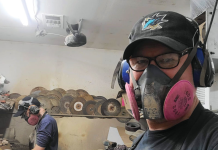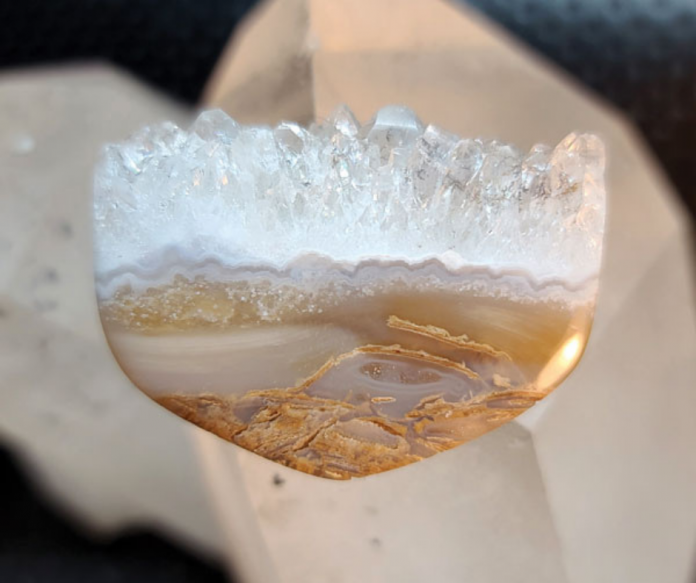
Glacier ice agate is a unique mix of opal and chalcedony layered on top of its host limestone layer. The limestone is sagenitic. The opal and chalcedony layer has a beautiful light blue tint, giving it the appearance of glacier ice, hence where it got its name. Much of this layer has a nice wispy movement to it, almost looking like ocean waves crashing the shoreline.
If all that isn’t enough, glacier ice agate also is found in pockets with wonderful crystal growth on top, giving lapidary artists so much more to work with when designing cabochons.
Where Glacier Ice Agate is Found
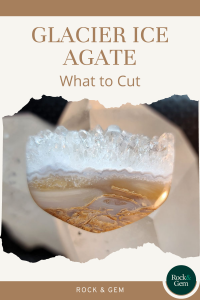
Glacier ice agate is another find by a prospector and avid lapidary, Larry Odom. This material is found in southwestern Wyoming, on an ancient sea bed somewhere between the butte on which the Blizzard stone was found, and the ridge filled with stromatolite. This material is found in large seams.
How to Cut Glacier Ice Agate
Much like many lace-type agates, there is a general direction to cut to get the profile you want. The top layer many times has quartz crystal growths, and the bottom layer is limestone, so when you start to slab this material, you want to cut from the top to bottom to reveal the lace profile. I find it best to hand-cut on a 10-inch saw if the stone will fit, and start your cuts straight into the quartz crystals. This way, you can retain as much of that crystal layer as possible without knocking several points off. If you cut from the other side, the chances are far greater for the usual blowout from the blade exiting the material and damaging the crystals.
Designing Cabs with Crystal Caps
Once you have finished cutting your slabs, the fun begins! Designing cabs with crystal caps, leaving it natural on top is a fan favorite right now. Utilize this area as much as possible, trimming out your preforms with a thin blade so that it won’t damage the crystals as you trim out your pieces.
If you obtain some material without the crystal cap, there’s still so much you can do when designing your cabs. Hunt out nice areas with an ocean wave scene, or look for fortifications in the agate layer to design your cab around. The possibilities are endless!
Starting the Cabbing Process
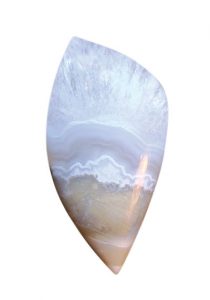
When starting the cabbing process, start on the 80 grit steel wheel, but go very gently on the edge of the crystals if you are working on one with the natural crystal top. Grind your girdle on the sides, but don’t go very far on the quartz just yet. Once the girdle is started, then continue doming the cab and go all the way across the top, even across the quartz crystal face.
From here many have a 220 steel wheel in their set up, but when cabbing materials with a natural crystal top, I like to switch immediately to soft resin wheels from this point. A 220 soft resin wheel would be optimal, but if you don’t have that, go ahead and lightly use your 220 steel, and leave the crystal area alone until you are ready to move onto the 280 soft resin grit wheels. This way you reduce the chances of chipping or even losing a few crystal points. This is a good time to stop, dry off your material and examine for scratches, as well as check the crystal cap for any embedded dirt. If there is dirt still within the crystals, this is the time to get out a fine wire brush and clean it all out before moving on.
Finishing Up
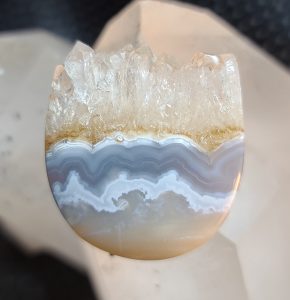
The rest is fairly easy and typical of cabbing any other type of agate, just be sure that no scratches remain after the 280 grit stage, and go all the way up to the 14,000 grit wheel, which will yield an amazing polish. There may be a slight bit of undercutting because of the hardness difference between the chalcedony and limestone, but this is to be anticipated and normal for this type of stone. There might also be a slight bit of difference in the glossy polish, where the chalcedony will have a much glossier finish as well.
At this point, you will have a beautifully finished cab, I wouldn’t suggest any further polishing compounds being used because it will fill in the bottom areas of the crystal growth and it will be next to impossible to get it out.
This What to Cut column about glacier ice agate previously appeared in Rock & Gem magazine. Click here to subscribe! Story and photos by Russ Kaniuth.




